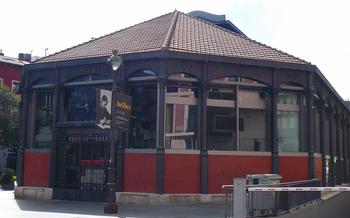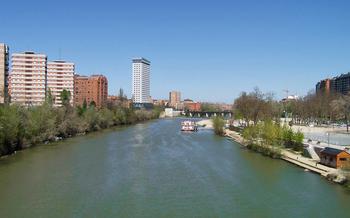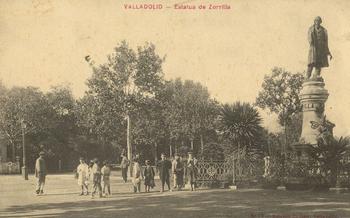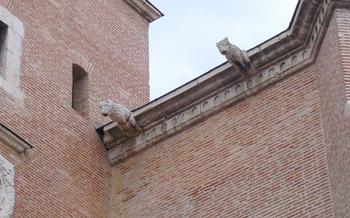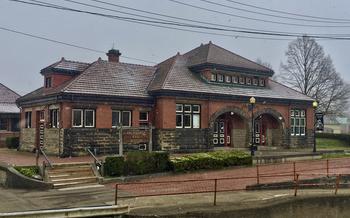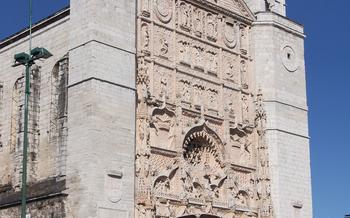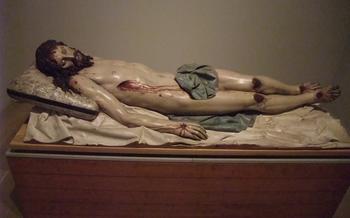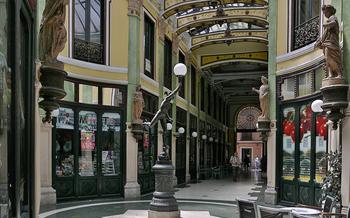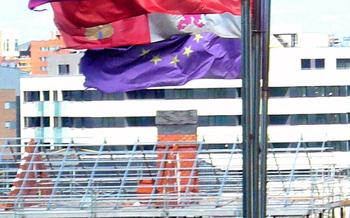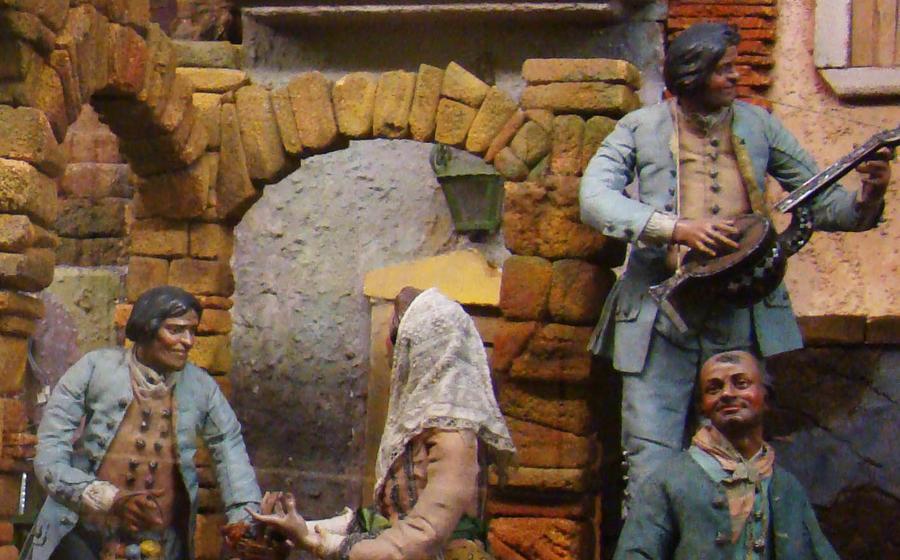
Belén Napolitano del Museo Nacional de Escultura
- The Belén Napolitano del Museo Nacional de Escultura
- Best Time to Visit
- Other Highlights of the Museum
- History of the Nativity Scene
- Figures and Scenes
- Practical Tips for Visiting
- Nearby Attractions
- Accommodation Options
- Transportation Options
- Food and Drink Recommendations
- Cultural Events and Festivals
- Insider Tip: Discover the Hidden Gems of Valladolid
The Belén Napolitano del Museo Nacional de Escultura
The Belén Napolitano del Museo Nacional de Escultura is one of the most nativity scene was created in the 18th century by Neapolitan craftsmen, and it is considered to be a masterpiece of the Baroque period.
The figures in the nativity scene are incredibly detailed and realistic, and they are arranged in a variety of scenes that depict the events surrounding the birth of Jesus. There are scenes of the Holy Family, the shepherds, the Three Wise Men, and the animals. There are also scenes of angels and demons, and of the everyday life of the people of Naples.
The symbolism of the nativity scene is rich and complex. The birth of Jesus is seen as a symbol of hope and renewal, and the nativity scene is a reminder of the importance of family. The message of peace and goodwill is also strong, and the contrast between light and darkness is a reminder of the struggle between good and evil.
Best Time to Visit
The best time to visit the Belén Napol the nativity scene is on full display and the museum is decorated for the holidays. The museum is open year-round, but the nativity scene is only on display from late November to early January**.
The peak season for tourism in Valladolid is during the summer months, when the weather is warm and sunny. However, this is also the time when the city is most crowded and expensive. For a more relaxed and enjoyable experience, it is best to visit during the shoulder seasons, in spring or fall.
The ideal weather conditions for visiting the museum are during spring or fall, when the temperatures are mild and pleasant. The museum is also less crowded during these times, making it easier to explore the exhibits at your own pace.
The museum occasionally hosts special events or exhibitions related to the nativity scene, so it is worth checking the museum's website before your visit to see what might be happening.
If you are looking to avoid crowds, it is best to visit the museum during the week rather than on the weekends. The museum is also less crowded in the morning and early afternoon.
Other Highlights of the Museum
In addition to the Belén Napolitano, the Museo Nacional de Escultura boasts an impressive permanent collection of sculptures spanning various periods and styles. Highlights include masterpieces by renowned Spanish artists such as Alonso Berruguete, Juan de Juni, and Gregorio Fernández. Temporary exhibitions showcasing works from both established and emerging artists are also regularly held at the museum. Guided tours are available for visitors who wish to delve deeper into the history and significance of the exhibits. The museum also offers educational programs designed to engage children and families with the world of sculpture. Through interactive workshops and activities, young visitors can learn about the techniques and processes involved in creating sculptures, while gaining an appreciation for the art form.
History of the Nativity Scene
The tradition of the nativity scene, also known as the crèche or belén, can be traced back to the Middle Ages. It is believed to have originated in Italy, where Saint Francis of Assisi first created a living nativity scene in the town of Greccio in 122Saint Francis wanted to recreate the scene of the birth of Jesus in order to help people understand the true meaning of Christmas. The tradition quickly spread throughout Europe, and by the 15th century, nativity scenes were being created all over the world.
Over time, the nativity scene evolved from a simple manger scene to a more elaborate and detailed representation of the birth of Jesus. New figures and scenes were added, and the nativity scene became a popular way to celebrate Christmas and teach children about the story of Jesus' birth.
There are many different styles and interpretations of the nativity scene, each reflecting the culture and traditions of the region where it was created. The Neapolitan nativity scene, which originated in Naples, Italy, is one of the most famous and elaborate styles of nativity scene. Neapolitan nativity scenes are known for their intricate craftsmanship, attention to detail, and use of a wide variety of materials.
Figures and Scenes
The Belén Napolitano del **Museo its bustling streets, vibrant markets, and grand churches. The nativity scene features over 500 intricately carved and painted figures, each representing a different character or scene from the Christmas story.
The Holy Family is depicted in the center of the nativity scene, with the Virgin Mary and Saint Joseph gazing lovingly at the Infant Jesus, who lies in a manger. The Three Wise Men are shown approaching the manger, bearing gifts of gold, frankincense, and myrrh.
The nativity scene also includes a variety of other figures, such as shepherds and their flocks, angels, and animals. The shepherds are shown tending to their sheep, while the angels sing and praise the newborn king. The animals include donkeys, oxen, sheep, and goats, all of which are depicted with a remarkable degree of realism.
In addition to the biblical scenes, the nativity scene also includes a number of secular scenes, such as a market, a tavern, and a wedding procession. These scenes provide a glimpse into the everyday life of 18th-century Naples and add a touch of humor and whimsy to the nativity scene.
Practical Tips for Visiting
To fully appreciate the beauty and significance of the Belén Napolitano, allow enough time to explore it thoroughly. The nativity scene is quite extensive, and each figure and scene is intricately detailed, so take your time to admire the craftsmanship and artistry.
Take advantage of the guided tours offered by the museum. These tours provide valuable insights into the history, symbolism, and artistic techniques of the nativity scene. The guides are knowledgeable and passionate about the subject, and they can help you understand and appreciate the nativity scene on a deeper level.
Be respectful of the exhibits and other visitors. The nativity scene is a delicate and fragile work of art, so please handle the figures with care and avoid touching them. Also, be mindful of other visitors and try to keep your voice down so that everyone can enjoy the experience.
Capture the beauty of the nativity scene through photography. The nativity scene is a visually stunning work of art, and it's worth capturing its beauty through photographs. However, please be respectful of the exhibits and other visitors when taking pictures. Use a flash only if necessary, and try not to disturb others.
Nearby Attractions
Valladolid is a city that overflows with cultural possibilities, and once you've had your fill of the nativity scene, there's still plenty to see and do. For the art enthusiast, Valladolid boasts a number of other museums, including the Museo Patio Herreriano, which houses a collection of contemporary art, and the Museo de Arte Africano, which showcases African art from across the continent.
If history is more your thing, Valladolid's rich past is on display at the Museo de Valladolid, which tells the story of the city from its Roman origins to the present day. And for those who want to experience the city's vibrant culture, there are plenty of options to choose from. Take a stroll through the Plaza Mayor, the city's main square, and admire the beautiful architecture, or visit the Teatro Calderón, a historic theater that hosts a variety of performances.
Valladolid is also a great city for shopping and dining. The pedestrianized Calle Santiago is lined with shops selling everything from clothes to souvenirs, while the Plaza Mayor is home to a number of restaurants and bars serving traditional Spanish cuisine. And if you're looking for a unique experience, take a day trip to the nearby town of Medina del Campo, where you can visit the Castillo de la Mota, a 15th-century castle that once served as a prison for Joan of Arc.
Accommodation Options
Valladolid offers a range of accommodation options to suit every budget and preference. For a luxurious stay, consider the five-star Hotel Zenit Valladolid, located just steps from the Museo Nacional de Escultura. The hotel features elegant rooms and suites, a rooftop terrace with panoramic city views, and a Michelin-starred restaurant.
For a more affordable option, try the centrally located Hostal Viena, which offers comfortable rooms and a friendly atmosphere. The hostel is within walking distance of the museum and other major attractions.
If you prefer self-catering accommodations, consider renting an apartment or vacation rental. Several websites, such as Airbnb and Booking.com, offer a wide range of options to choose from. This can be a great option for families or groups traveling together.
To find the best deals on accommodation, it's advisable to book in advance, especially during peak tourist season. Consider checking online travel agencies or directly contacting the hotel or rental owner to inquire about discounts or special offers.
Transportation Options
Valladolid is a compact city, making it easy to get around on foot or by bicycle. Most of the city's attractions, including the Museo Nacional de Escultura, are located within walking distance of each other.
Public Transportation
Valladolid has an efficient public transportation system that consists of buses and trams. The buses cover a wide area of the city, and the trams connect the city center with the suburbs. Tickets can be purchased from vending machines at bus stops or from the driver.
Renting a Car or Bicycle
If you prefer to explore the city at your own pace, you can rent a car or a bicycle. Several car rental agencies are located in the city center, and there are also a number of bike rental shops.
Taxis and Ride-Sharing Services
Taxis are another convenient way to get around Valladolid. They can be hailed on the street or ordered through a ride-sharing app.
Tips for Navigating the City
- When exploring Valladolid on foot, be sure to wear comfortable shoes as the streets can be cobbled.
- If you are renting a car, be aware that parking can be difficult in the city center.
- Taxis are a good option for getting around at night or if you have luggage.
- Valladolid is a safe city, but it is always advisable to be aware of your surroundings, especially at night.
Food and Drink Recommendations
Valladolid's culinary scene is a delight for food enthusiasts, offering a diverse range of traditional Spanish cuisine, local specialties, and modern gastronomic creations. When visiting the city, be sure to savor the flavors of the region at one of the many excellent restaurants.
Traditional Spanish Cuisine
For a taste of authentic Spanish cuisine, try the hearty cocido maragato, a stew made with chickpeas, pork, and vegetables. Another local delicacy is lechazo asado, a roasted suckling lamb that is tender and flavorful. Don't miss out on the tapas, small plates of savory snacks that are perfect for sharing.
Local Specialties and Delicacies
Valladolid is known for its unique local specialties, such as the pinchos morunos, skewers of marinated pork or lamb grilled over an open fire. Another must-try is the sopa castellana, a traditional Castilian soup made with bread, garlic, and paprika. For a sweet treat, indulge in the torrijas, slices of bread soaked in milk and egg, then fried and sprinkled with sugar and cinnamon.
Vegetarian and Vegan Options
Vegetarian and vegan visitors will find plenty of delicious options in Valladolid. Many restaurants offer vegetable-based dishes, such as grilled vegetables, stews, and salads. There are also several dedicated vegetarian and vegan restaurants in the city, where you can enjoy a variety of plant-based cuisine.
Tips for Finding the Best Restaurants
To find the best restaurants in Valladolid, ask for recommendations from locals or your hotel concierge. You can also check online reviews and ratings to get an idea of what other diners have to say. Be sure to make reservations in advance, especially for popular restaurants during peak season.
With its rich culinary heritage and diverse dining options, Valladolid is a foodie's paradise. So, come hungry and explore the city's gastronomic delights!
Cultural Events and Festivals
Valladolid is a city that lives and breathes culture. Throughout the year, the city hosts a variety of events and festivals that showcase its rich history, traditions, and artistic heritage.
One of the most popular events is the Valladolid International Film Festival, which takes place every October. The festival screens a diverse range of films from around the world, including independent films, documentaries, and short films.
Another major event is the Valladolid Carnival, which takes place in February. The carnival is a colorful and lively celebration that features parades, music, dancing, and costumes.
For those interested in the arts, the Valladolid Museum of Contemporary Art hosts a variety of exhibitions throughout the year. The museum's collection includes works by both Spanish and international artists.
Valladolid is also home to a number of traditional festivals, such as the Feast of Saint Peter Regalado and the Feast of Our Lady of San Lorenzo. These festivals are celebrated with religious processions, music, dancing, and food.
To experience the true essence of Valladolid, be sure to attend one of the city's many cultural events or festivals. These events are a great way to learn about the city's history, traditions, and people.
Insider Tip: Discover the Hidden Gems of Valladolid
-
Beyond the well-known attractions, Valladolid offers a wealth of hidden gems waiting to be discovered.
-
Explore the lesser-known neighborhoods such as Barrio de las Delicias, with its charming streets and vibrant street art.
-
Wander through the Campo Grande Park, a tranquil oasis with beautiful gardens, fountains, and sculptures.
-
Visit the Museo Oriental, home to a fascinating collection of Asian art and artifacts.
-
Get off the beaten path and find unique experiences like attending a traditional Spanish cooking class or exploring the city's vibrant nightlife scene.
-
Embrace the opportunity to connect with locals, learn about their culture, and create lasting memories in Valladolid.
